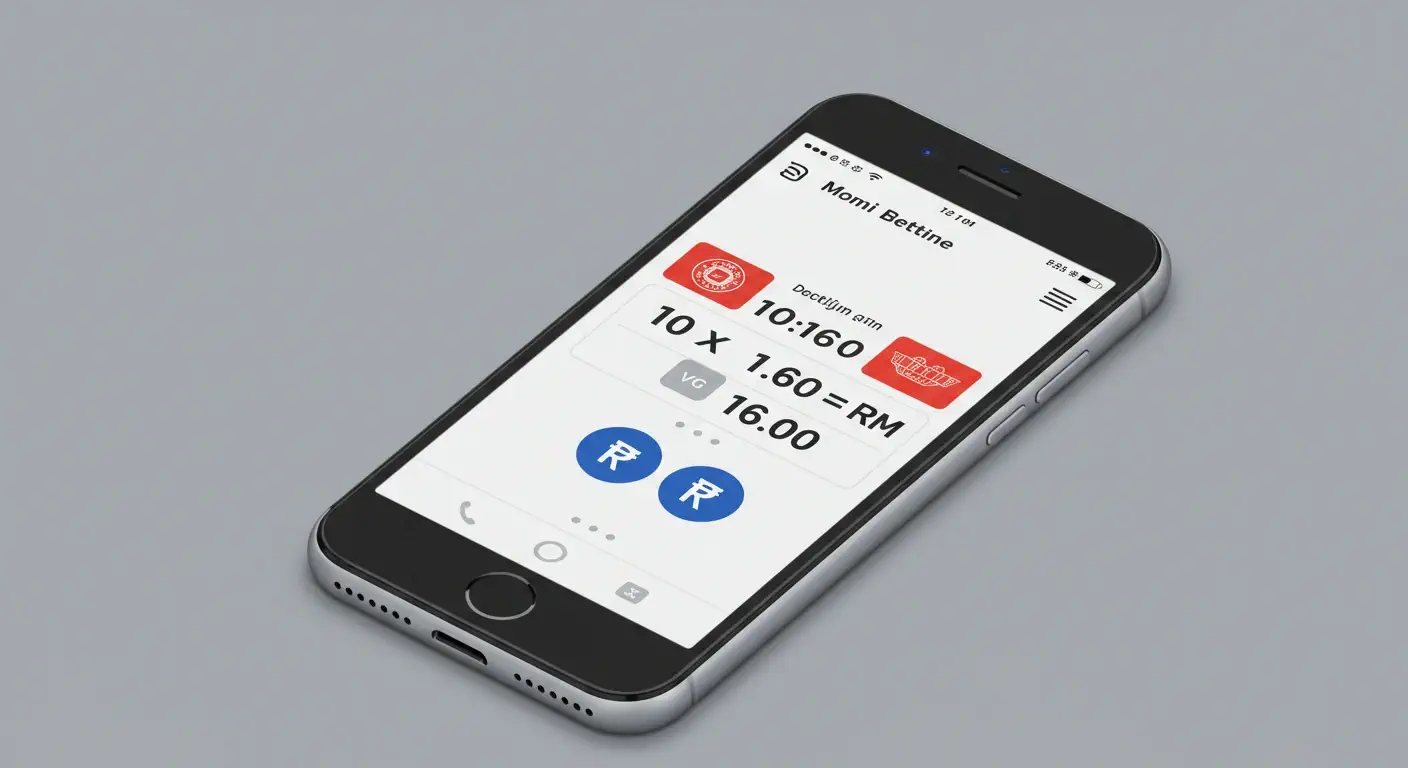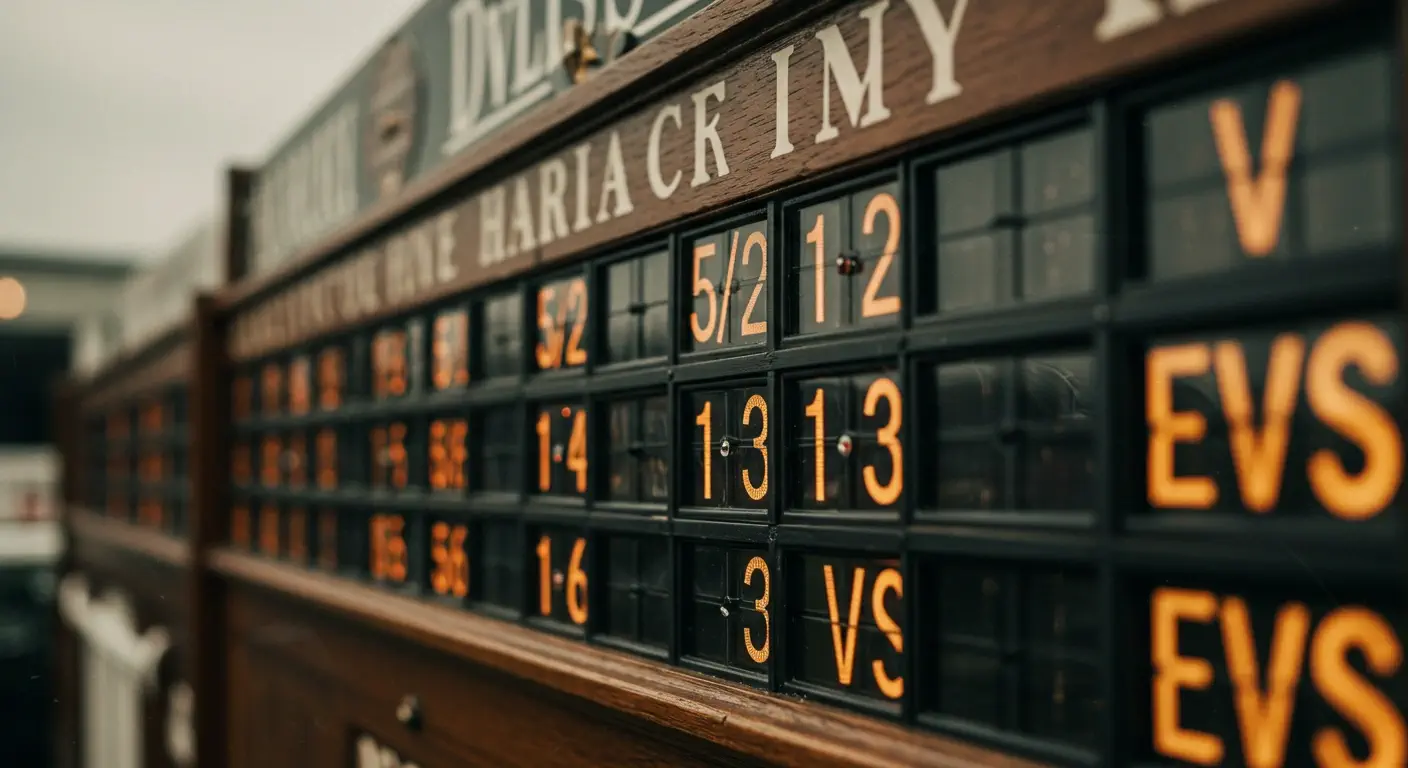Ever watched a thrilling football match – maybe your favourite English Premier League team battling it out, or perhaps a crucial badminton final – and seen those numbers pop up next to the players or teams? Numbers like 1.85, 5/2, or +150? Yeah, those. They’re betting odds, and honestly, they can look like a secret code cooked up by mathematicians. I remember squinting at them myself, wondering what on earth they meant.
But here’s the good news: they’re not actually that complicated once you break them down. Think of them as the language bookmakers use to tell you two crucial things: the likelihood (or probability) they think something has of happening, and how much money you could potentially win if your prediction is right.
Here in Malaysia, whether you’re discussing the latest football results over teh tarik or following international sports online, seeing these odds is becoming more common. So, understanding them isn’t just about betting (if that’s your thing); it’s about understanding a part of the global sports conversation.
This guide is your key to unlocking that code. We’ll walk through the three main types of odds you’ll encounter – Decimal, Fractional, and American – step-by-step. No confusing jargon, just simple explanations, real examples, and maybe a little insight along the way. By the end, you’ll be able to glance at those numbers and know exactly what they’re telling you. Let’s get started.
First Things First: What Exactly Are Betting Odds?
Before we jump into the different styles, let’s nail down the basics. What are betting odds fundamentally?
At their core, betting odds represent a ratio. They show the relationship between the amount you bet (your stake) and the potential winnings you could receive. But they do more than just signal potential payout; they also give you a clue about probability.
Imagine a simple coin toss. There are two outcomes: heads or tails. The true probability of getting heads is 50% (or 1 out of 2). If betting were purely about probability, the odds might reflect that perfectly. However, bookmakers aren’t just calculating chances; they’re running a business.
They set odds to attract betting on all outcomes of an event, not just the favourite. They also build in a margin (often called the ‘vig’ or ‘juice’) to help ensure they make a profit regardless of the result. So, the odds you see aren’t always the pure, unadulterated probability, but rather the bookmaker’s assessment adjusted for market factors and their margin.
Think of it like this: The odds are the bookie’s way of saying, “Based on what we know and how others are betting, this is how likely we think this outcome is, and this is what we’re willing to pay if you predict it correctly.”
Understanding this basic concept is crucial before we tackle the specific formats. It helps you see odds not just as payout numbers, but as indicators of perceived likelihood.
Why So Many Types? Decimal, Fractional, American Explained
Okay, so if odds basically do the same job, why the different formats? It mostly boils down to tradition and geography.
-
Fractional Odds: These are the old-school originals, deeply rooted in the UK and Irish horse racing scenes. If you’ve ever watched classic British sports coverage, you’ve likely seen these.
-
Decimal Odds: These are more common across Europe, Australia, Canada, and increasingly, on online platforms worldwide. Many find them the simplest to understand at first glance.
-
American Odds: As the name suggests, these are primarily used in the United States. They have a unique way of showing favourites and underdogs using plus (+) and minus (-) signs.
You might encounter any of these online, especially on international betting sites. Knowing how to read all three means you’re never caught off guard. Let’s break each one down.
Decoding Decimal Odds: The Simple Calculator
Let’s start with what many find the easiest: Decimal Odds. You’ll often see these displayed as numbers with decimal points, like 1.75, 2.00, or 3.50.
The Magic Formula: The beauty of decimal odds lies in their simplicity. The number you see represents the total amount you’ll get back for every RM1 (or dollar, or any currency unit) you bet, including your original stake.
Total Payout = Stake x Decimal Odds
Example Time:
Let’s say you’re watching a badminton match featuring Lee Zii Jia. The decimal odds for him to win are 1.60. You decide to place a RM10 bet on him winning.
-
Calculation: RM10 (Your Stake) x 1.60 (Decimal Odds) = RM16.00 (Total Payout)
So, if Lee Zii Jia wins, you’ll receive RM16.00 back from the bookmaker.
Hold on, where’s my profit?
Good question! Remember, the decimal odds calculation gives you the total return. To figure out your actual profit, just subtract your original stake:
-
Profit = Total Payout – Stake
-
Profit = RM16.00 – RM10.00 = RM6.00
Why Decimal Odds Rock (Pros):
-
Super Simple Calculation: It’s arguably the easiest format for calculating your total return quickly.
-
Stake Included: The number directly tells you your total potential payout, stake included.
-
Widely Used Online: Most international betting platforms offer decimal odds, making them very common.
The Small Catch (Cons):
-
Profit Isn’t Obvious: You need that extra step (subtracting the stake) to see your pure profit.
For many, especially those new to betting odds or primarily betting online, decimal odds feel the most intuitive. Think of it as the straightforward friend who tells you exactly what you’ll get back in total.

Unpacking Fractional Odds: The Traditional Flavour
Next up, Fractional Odds. These look like, well, fractions – 5/1, 7/2, 1/3. They tell you the potential profit relative to your stake.
The Core Idea: The fraction shows how much profit you’ll make based on your bet amount.
Profit = Stake x (Numerator / Denominator)
Let’s Break It Down:
-
The number on the right (denominator) is typically what you need to bet to win the amount on the left (numerator).
-
So, 5/1 means you win RM5 in profit for every RM1 you bet.
-
7/2 means you win RM7 in profit for every RM2 you bet.
Example Time:
Imagine Manchester City is playing Arsenal, and the fractional odds for Man City to win are 4/5 (read as “four-to-five”). You place a RM10 bet.
-
Calculation: RM10 (Your Stake) x (4 / 5) = RM10 x 0.8 = RM8.00 (Profit)
If Man City wins, you make a profit of RM8.00. Your total return would be your profit plus your original stake:
-
Total Return = Profit + Stake
-
Total Return = RM8.00 + RM10.00 = RM18.00
Another Example (Underdog):
What if the odds were 3/1 for Arsenal to win? You bet RM10.
-
Calculation: RM10 (Your Stake) x (3 / 1) = RM10 x 3 = RM30.00 (Profit)
-
Total Return = RM30.00 + RM10.00 = RM40.00
“Odds On” vs. “Odds Against”:
Fractional odds make it easy to spot the favourite vs. the underdog:
-
Odds Against: When the first number (numerator) is bigger than the second (denominator), like 3/1 or 5/2. This means the potential profit is more than your stake. This usually indicates an underdog or a less likely outcome.
-
Odds On: When the first number is smaller than the second, like 4/5 or 1/2. This means the potential profit is less than your stake. This usually indicates a favourite or a more likely outcome.
-
Evens: Odds of 1/1 (sometimes written as EVS) mean your profit equals your stake.
Why Fractional Odds Have Staying Power (Pros):
-
Profit Clarity: They directly tell you the potential profit relative to your stake.
-
Tradition: Familiar to those who follow UK-centric sports or have been around betting longer.
-
Clear Favourite/Underdog: Easy to see “odds on” vs. “odds against.”
Where They Can Trip You Up (Cons):
-
Calculation Quirks: Calculating total return requires adding the stake back. Comparing odds like 7/4 and 9/5 isn’t immediately obvious without calculation.
Fractional odds are like the classic recipe – tried and true, tells you exactly what extra flavour (profit) you’ll get, but might require a little more measuring (calculation) than the modern microwave meal (decimal odds).

Cracking the Code: American Odds Explained
Now for the one that often looks the most alien at first glance: American Odds (also known as Moneyline Odds). These use plus (+) and minus (-) signs followed by a number (e.g., +150, -200).
Don’t let the signs intimidate you! They simply tell you two different things depending on whether it’s positive or negative.
The Minus Sign (-): The Favourite
-
A negative number (e.g., -150) shows how much money you need to bet to win RM100 in profit.
-
Think of it as: “Risk this amount to win RM100.”
Example:
Let’s say the odds for Team A to win are -120.
-
This means you need to bet RM120 to potentially win RM100 profit.
-
If you bet RM120 and Team A wins, you get back RM220 (your RM120 stake + RM100 profit).
What if you bet a different amount?
You can scale it. If you bet RM60 (half of RM120) at -120 odds, your potential profit would be RM50 (half of RM100).
-
Calculation for Profit (Negative Odds): (100 / Odds Number) x Stake
-
(100 / 120) x RM60 = 0.8333 x RM60 = RM50 Profit
-
-
Total Return = RM60 + RM50 = RM110
The Plus Sign (+): The Underdog
-
A positive number (e.g., +250) shows how much profit you’ll win for every RM100 you bet.
-
Think of it as: “Risk RM100 to win this amount.”
Example:
Team B has odds of +200 to win.
-
This means if you bet RM100, you could potentially win RM200 in profit.
-
If you bet RM100 and Team B wins, you get back RM300 (your RM100 stake + RM200 profit).
Scaling it:
If you bet RM50 at +200 odds:
-
Calculation for Profit (Positive Odds): (Odds Number / 100) x Stake
-
(200 / 100) x RM50 = 2 x RM50 = RM100 Profit
-
-
Total Return = RM50 + RM100 = RM150
Why American Odds Exist (Pros):
-
Clear Favourite/Underdog: The +/- system instantly tells you who is favoured.
-
Standard in US Sports: Essential if you follow or bet on sports like NFL, NBA, MLB.
The Learning Curve (Cons):
-
Two Calculations: You need to remember two different ways to calculate potential profit based on the sign.
-
RM100 Focus: The base unit of RM100 can feel arbitrary if you’re betting smaller or larger amounts, requiring scaling.
American odds are a bit like learning a new dialect – takes a moment to get used to the +/- grammar, but once you do, it clearly signals the status (favourite/underdog) in its own unique way.

Side-by-Side: Seeing the Same Story in Different Languages
It might seem like three totally different systems, but remember: Decimal, Fractional, and American odds are just different ways of expressing the same likelihood and potential payout.
Let’s see how the same scenario looks in all three formats. Imagine an event where the implied probability suggests:
-
Outcome A has roughly a 60% chance (the favourite).
-
Outcome B has roughly a 30% chance (the underdog).
The odds might look something like this (Note: actual odds include bookmaker margins, so these are illustrative):
| Feature | Decimal Odds | Fractional Odds | American Odds | Implied Probability (Approx) |
| Outcome A | 1.67 | 4/6 (or 2/3) | -150 | ~60% |
| Outcome B | 3.33 | 7/3 (approx) | +233 | ~30% |
| Stake | RM10 | RM10 | RM10 | |
| Potential Win (A) | RM16.70 (Total) | RM6.70 (Profit) | RM6.70 (Profit) | |
| Potential Win (B) | RM33.30 (Total) | RM23.30 (Profit) | RM23.30 (Profit) |
(Table Explanation): This table shows how the same bet on Outcome A or Outcome B might be represented. Notice how the potential profit (after accounting for the stake in decimal odds) is essentially the same across formats. Seeing them side-by-side really helps solidify that they’re just different dialects of the same language.
Going Deeper: What is Implied Probability?
We touched on this earlier. Odds don’t just tell you the payout; they hint at the probability the bookmaker assigns to an outcome. This is called Implied Probability. Calculating it can help you assess if you think the odds offer ‘value’ – meaning, do you think the actual chance of something happening is higher than what the odds suggest?
How to Calculate Implied Probability (Simplified):
-
Decimal Odds: (1 / Decimal Odds) x 100%
-
Example: Odds = 2.00 -> (1 / 2.00) x 100% = 50%
-
Example: Odds = 1.50 -> (1 / 1.50) x 100% = 66.7%
-
-
Fractional Odds: (Denominator / (Numerator + Denominator)) x 100%
-
Example: Odds = 3/1 -> (1 / (3 + 1)) x 100% = (1 / 4) x 100% = 25%
-
Example: Odds = 4/5 -> (5 / (4 + 5)) x 100% = (5 / 9) x 100% = 55.6%
-
-
American Odds:
-
Negative (-): (Odds Number / (Odds Number + 100)) x 100%
-
Example: Odds = -150 -> (150 / (150 + 100)) x 100% = (150 / 250) x 100% = 60%
-
-
Positive (+): (100 / (Odds Number + 100)) x 100%
-
Example: Odds = +200 -> (100 / (200 + 100)) x 100% = (100 / 300) x 100% = 33.3%
-
-
Why Bother?
Understanding implied probability shifts your perspective. Instead of just asking “How much can I win?”, you start asking, “Are the odds accurately reflecting the real chances?” If you believe a team has a 50% chance of winning, but the odds imply only a 40% chance (e.g., decimal odds of 2.50), you might see that as a value opportunity. It adds another layer to your analysis.
It’s like looking at the price tag on a shirt (the odds) and then deciding if the quality and style (your assessment of probability) make it worth the price.
Putting It All Together: Reading Odds Like a Pro
Okay, deep breaths. We’ve covered a lot. Let’s condense the key takeaways:
-
Odds = Probability + Payout: They reflect the bookmaker’s view of likelihood and determine your potential winnings.
-
Three Main Styles: Decimal (total return), Fractional (profit vs. stake), American (+/- indicating favourite/underdog and payout structure). They all tell the same story differently.
-
Know Your Calculations:
-
Decimal: Stake x Odds = Total Return
-
Fractional: Stake x (Num / Denom) = Profit
-
American (-): Bet the number to win RM100 profit.
-
American (+): Bet RM100 to win the number in profit.
-
-
Implied Probability: Use it to gauge if odds align with your own assessment of chances.
-
Context Matters: The type of odds you see most often might depend on where you are or the platform you use. Being versatile is key.
A Final Tip: Most online betting platforms allow you to switch between odds formats. Find one you’re comfortable with, but knowing how to read the others is still a valuable skill!
So, Are You Ready to Decode the Numbers?
Navigating the world of betting odds doesn’t have to feel like deciphering ancient hieroglyphs. As we’ve seen, whether it’s the straightforward calculation of Decimal odds, the traditional profit view of Fractional odds, or the favourite/underdog clarity of American odds, each format has its own logic.
The real power comes not just from knowing how to calculate potential winnings, but from understanding what the odds are telling you about probability and the bookmaker’s perspective. It’s about moving from confusion to confidence, being able to look at those flashing numbers during a game and actually understand the story they’re telling.
I hope this breakdown has demystified things for you. Think of it as adding a new lens through which to view the sports you love. It’s not about encouraging betting, but about empowering understanding. Knowledge, after all, is always a good bet.

